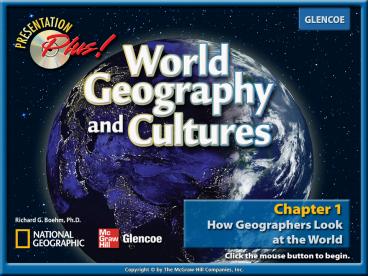Chapter Menu - PowerPoint PPT Presentation
1 / 15
Title:
Chapter Menu
Description:
Chapter Menu Chapter 1 Intro Chapter Overview Geography is the study of the earth's physical features and the living things that inhabit the planet. – PowerPoint PPT presentation
Number of Views:263
Avg rating:3.0/5.0
Title: Chapter Menu
1
(No Transcript)
2
Chapter Menu
Introduction Section 1 Geography Skills
Handbook Section 2The Geographers Craft Summary
3
Chapter 1 Intro
Essential Questions 1) What is
geography? 2) What skills does knowledge of
geography provide?
Geography is used to interpret the past,
understand the present, and plan for the future.
News coverage of local, national, and
international events is part of daily life in the
twenty-first century. An understanding of
geography will help you learn how such events
affect your life.
4
Chapter Overview
- Geography is the study of the earth's physical
features and the living things that inhabit the
planet. - Geographers use many tools and methods to study
and understand the world's places. - Investigating the relationships among human
activities, the earth's physical systems, and the
environment, the study of geography can
contribute to a better future for the world's
people.
5
Geography Skills Handbook
- Globes, Maps and Projections Those who study
geography use different ways of looking at the
world or the essential elements of geographythe
world in spatial terms, places and regions,
physical systems, human systems, and environment
and society.
6
Geography Skills Handbook
- Map Projections
7
Determining Location
- When geographers study the earth in spatial
terms, they focus on where places are located.
Location can be expressed as absolute location or
relative location. - The basic tool for answering the question
Where? is location. - A grid system on maps and globes helps you find
exact places on the Earths surface. - A hemisphere is one of the halves into which the
Earth is divided. Most places are located in two
of the four hemispheres.
8
Determining Location (cont.)
- Latitude
- Lines of latitude, or parallels, circle the
Earth parallel to the Equator and measure the
distance north or south of the Equator in
degrees. - The Equator is measured at 0 latitude, while
the Poles lie at latitudes 90N (north) and
90S (south). - Parallels north of the Equator are called north
latitude. Parallels south of the Equator are
called south latitude.
9
Determining Location (cont.)
- Longitude
- Lines of longitude, or meridians, circle the
Earth from Pole to Pole. - These lines measure distance east or west of the
Prime Meridian at 0 longitude. - Meridians east of the Prime Meridian are known
as east longitude. Meridians west of the Prime
Meridian are known as west longitude. - The 180 meridian on the opposite side of the
Earth is called the International Date Line.
10
Determining Location (cont.)
- The Global Grid
- Every place has a global address, or
absolute location. - Absolute location of a place can be identified
by naming the latitude and longitude lines that
cross exactly at that place.
11
Themes in Geography
- Geographers also group places, or particular
spaces with physical and human meaning, into
regions with similar physical or human
characteristics. - They study of Earth's physical systems which
involves the effects of natural phenomena and
ecosystem on the earth's surface.
12
Themes in Geography
- Geographers also look at human systems to see how
people settle the earth, form societies, create
permanent features, and move from place to place.
Human-environment interaction focuses on the
relationship between people and their physical
environment.
13
The Geographer's Craft
- Physical geography and human geography are the
two major branches of geography. - Geographers use research methods and tools to
study places and human activity, including direct
observation, mapping, interviewing, statistics,
and technology. - Scientific instruments, such as satellites and
computers, gather and organize data that is used
by geographers, planners, and governments. - Computers have revolutionized the process of
mapmaking, providing much greater precision and
making rapid changes possible. - Geographers study the relationships among the
physical and human features of the earth by using
other disciplines such as history, government,
culture, and economics. - Geography skills are useful in many different
careers, which often require a combination of
training in geography and other areas of study.
14
(No Transcript)
15
THE END
- Chapter 1 Test
- Coming Soon
- STUDY TONIGHT!































